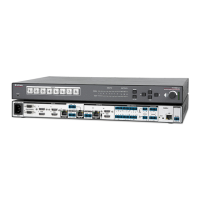IN1608 xi Scaling Presentation Switcher • SIS Configuration and Control 52
X4)
= IP address xxx.xxx.xxx.xxx
(192.168.254.254 = default)
X4!
= Subnet mask xxx.xxx.xxx.xxx (255.255.0.0 = default)
X4@
= Gateway address xxx.xxx.xxx.xxx (0.0.0.0 = default)
X4#
= MAC address
00-05-A6-xx-xx-xx
X4$
= Number of open connections
0-<maximum number of open connections>
X4%
= Config type 0 = IP config
1 = device-specific parameters
X4^
= Volume group number
1 = program volume
3 = mic volume
8 = variable volume
X4&
= Group volume level -1000 to 0, where -1000 = -100 dB or
0% volume and 0 = 0 dB or 100% volume
X4*
= Mute group number 2 = program mute
4 = mic mute
7 = output mute
X4(
= Bass and treble group
number
5 = bass control
6 = treble control
X5)
= Bass and treble level -240 to +120, where -240 = -24 dB and
+120 = 12 dB
X5!
= Increment value dB value multiplied by ten, in 0.1 dB increments,
to raise or lower a group fader (for example,
100 = 10 dB)
X5@
= Password Up to 128 digits and alphanumeric characters
for user or admin passwords.
NOTE: / \ | * and space are invalid characters.
X5#
= Verbose mode 0 = clear or none (default for Telnet connections)
1 = verbose mode (default for RS-232 and USB)
2 = tagged responses for queries
3 = verbose mode and tagged for queries
NOTES:
• In verbose response mode, the IN1608 xi responds with unsolicited responses
for value and setting changes that may result from a signal change, or a setting
adjustment made via another interface.
For example, the scaler can send out a notice of a change in some setting without
receiving a query via a PC or a control system. That change could have been a result
of an internal process or a selection made via the PCS program. This is an example
of a verbose (wordy) relationship between the controller and a connected device.
• If tagged responses are enabled, all “view” commands return the command string
plus the data, the same as in responses for setting a value. For example, for the
following View Video Input Format command:
Command:
X!
\
Response: Typ
X!
*
X#]
(tagged response)
or
X#
]
(untagged response)
X5$
= Auto switch mode 0 = disable (default)
1 = prioritizes the highest numbered active input
2 = prioritizes the lowest numbered active input

